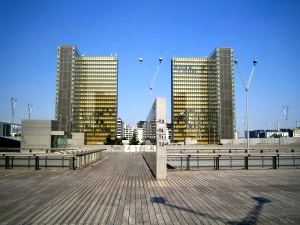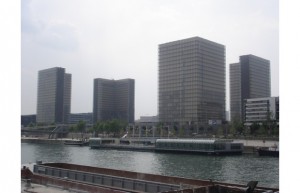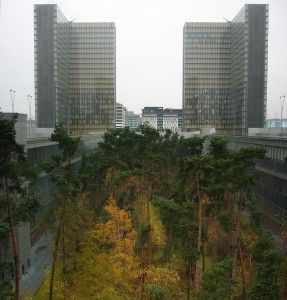#12. Bibliotheque Nationale

Bibliothèque Nationale DeFrance – BNF
Apresentaçãas coleções bibliográficas e dos serviços disponíveis pela BNF aos utilizadores.
 #12. Bibliotheque Nationale Location: Paris, France Architect: Henri Labrouste Year: 1868
#12. Bibliotheque Nationale Location: Paris, France Architect: Henri Labrouste Year: 1868
Hidden inside a heavy exterior, the reading room of the Bibliotheque Nationale in Paris is a monument to Henri Labrouste’s inventive use of cast iron. Using slender columns, Labrouste offered a heaven for library patrons, his modern approach both daring and instantly recongnizable.
The Bibliothèque nationale de France (BnF, IPA: [bi.bli.jɔ.tɛk na.sjɔ.nal də fʁɑ̃s]) is the National Library of France, located in Paris. It is intended to be the repository of all that is published in France. The current president of the library is Bruno Racine.
History
 The National Library of France traces its origin to the royal library founded at the Louvre Palace by Charles V in 1368. Charles had received a collection of manuscripts from his predecessor, John II, and transferred them to the Louvre from the Palais de la Cité. The first librarian of record was Claude Mallet, the king’s valet de chambre, who made a sort of catalogue, Inventoire des Livres du Roy nostre Seigneur estans au Chastel du Louvre. Jean Blanchet made another list in 1380 and Jean de Bégue one in 1411 and another in 1424. Charles V was a patron of learning and encouraged the making and collection of books. It is known that he employed Nicholas Oresme, Raoul de Presle and others to transcribe ancient texts. At the death of Charles VI, this first collection was unilaterally bought by the English regent of France, the Duke of Bedford, who transferred it to England in 1424. It was apparently dispersed at his death in 1435.
The National Library of France traces its origin to the royal library founded at the Louvre Palace by Charles V in 1368. Charles had received a collection of manuscripts from his predecessor, John II, and transferred them to the Louvre from the Palais de la Cité. The first librarian of record was Claude Mallet, the king’s valet de chambre, who made a sort of catalogue, Inventoire des Livres du Roy nostre Seigneur estans au Chastel du Louvre. Jean Blanchet made another list in 1380 and Jean de Bégue one in 1411 and another in 1424. Charles V was a patron of learning and encouraged the making and collection of books. It is known that he employed Nicholas Oresme, Raoul de Presle and others to transcribe ancient texts. At the death of Charles VI, this first collection was unilaterally bought by the English regent of France, the Duke of Bedford, who transferred it to England in 1424. It was apparently dispersed at his death in 1435.
Charles VII did little to repair the loss of these books, but the invention of printing resulted in the starting of another collection in the Louvre inherited by Louis XI in 1461. Charles VIII seized a part of the collection of the kings of Aragon. Louis XII, who had inherited the library at Blois, incorporated the latter into the Bibliothèque du Roi and further enriched it with the Gruthuyse collection and with plunder from Milan. Francis I transferred the collection in 1534 to Fontainebleau and merged it with his private library. During his reign, fine bindings became the craze and many of the books added by him and Henry II are masterpieces of the binder’s art.
Under librarianship of Amyot, the collection was transferred to Paris during which process many treasures were lost. Henry IV again moved it to the Collège de Clermont and in 1604 it was housed in the Rue de la Harpe. The appointment of Jacques Auguste de Thou as librarian initiated a period of development that made it the largest and richest collection of books in the world. He was succeeded by his son who was replaced, when executed for treason, by Jérôme Bignon, the first of a line of librarians of the same name. Under de Thou, the library was enriched by the collections of Queen Catherine de Medici. The library grew rapidly during the reigns of Louis XIII and Louis XIV, due in great part to the interest of the Minister of Finance, Colbert, an indefatigable collectors of books.
 The quarters in the Rue de la Harpe becoming inadequate, the library was again moved, in 1666, to a more spacious house in Rue Vivienne. The minister Louvois took quite as much interest in the library as Colbert and during his administration a magnificent building to be erected in the Place Vendôme was planned. The death of Louvois, however, prevented the realization of this plan. Louvois employed Mabillon, Thévenot and others to procure books from every source. In 1688 a catalogue in eight volumes was compiled.
The quarters in the Rue de la Harpe becoming inadequate, the library was again moved, in 1666, to a more spacious house in Rue Vivienne. The minister Louvois took quite as much interest in the library as Colbert and during his administration a magnificent building to be erected in the Place Vendôme was planned. The death of Louvois, however, prevented the realization of this plan. Louvois employed Mabillon, Thévenot and others to procure books from every source. In 1688 a catalogue in eight volumes was compiled.
The library opened to the public in 1692, under the administration of Abbé Louvois, Minister Louvois’s son. Abbé Louvois was succeeded by the Abbé Bignon, or Bignon II as he was termed, who instituted a complete reform of the library’s system. Catalogues were made which appeared from 1739-53 in 11 volumes. The collections increased steadily by purchase and gift to the outbreak of the French Revolution, at which time it was in grave danger of partial or total destruction, but owing to the activities of Antoine-Augustin Renouard and Joseph Van Praet it suffered no injury.
The library’s collections swelled to over 300,000 volumes during the radical phase of the French Revolution when the private libraries of aristocrats and clergy were seized. After the establishment of the French First Republic in September 1792, “the Assembly declared the Bibliotheque du Roi to be national property and the institution was renamed the Bibliothèque Nationale. After four centuries of control by the Crown, this great library now became the property of the French people.”
An new administrative organization was established. Napoleon took great interest in the library and among other things issued an order that all books in provincial libraries not possessed by the Bibliothèque Nationale should be forwarded to it, subject to replacement by exchanges of equal value from the duplicate collections, making it possible, as Napoleon said, to find a copy of any book in France in the National Library. Napoleon furthermore increased the collections by spoil from his conquests. A considerable number of these books was restored after his downfall. During the period from 1800 to 1836, the library was virtually under the control of Joseph Van Praet. At his death it contained more than 650,000 printed books and some 80,000 manuscripts.
Following a series of regime changes in France, it became the Imperial National Library and in 1868 was moved to newly constructed buildings on the Rue de Richelieu designed by Henri Labrouste. Upon Labrouste’s death in 1875 the library was further expanded, including the grand staircase and the Oval Room, by academic architect Jean-Louis Pascal. In 1896, the library was still the largest repository of books in the world, although it has since been surpassed by other libraries for that title. By 1920 the library’s collection had grown to 4,050,000 volumes and 11,000 manuscripts.
“M. Henri Lemaître, a vice-president of the French Library Association and formerly librarian of the Bibliothèque Nationale… outlined the story of French libraries and librarians during the German occupation, a record of destruction and racial discrimination. During 1940-1945, more than two million books were lost through the ravages of war, many of them forming the irreplaceable local collections in which France abounded. Many thousands of books, including complete libraries, were seized by the Germans. Yet French librarians stood firm against all threats, and continued to serve their readers to the best of their abilities. In their private lives and in their professional occupations they were in the van of the struggle against the Nazis, and many suffered imprisonment and death for their devotion. Despite Nazi opposition they maintained a supply of books to French prisoners of war. They continued to supply books on various proscribed lists to trustworthy readers; and when liberation came, they were ready with their plans for rehabilitation with the creation of new book centres for the French people on lines of the English county library system.”
New buildings:
Bibliothèque Nationale de France
On 14 July 1988, President François Mitterrand announced the construction and the expansion of one of the largest and most modern libraries in the world, intended to cover all fields of knowledge, and designed to be accessible to all, using the most modern data transfer technologies, which could be consulted from a distance, and which would collaborate with other European libraries. Surprisingly, the library does not maintain a wireless network. In July 1989, the services of the architectural firm of Dominique Perrault were retained. The construction was carried out by Bouygues. Construction of the library ran into huge cost overruns and technical difficulties related to its high-rise design, so much so that it was referred to as the “TGB” or “Très Grande Bibliothèque” (i.e. “Very Large Library,” a sarcastic allusion to France’s successful high-speed rail system, the TGV). After the move of the major collections from the rue de Richelieu, the National Library of France was inaugurated on 15 December 1996. It contains more than ten million volumes. The library retains the use of the rue de Richelieu complex for some of its collections.
Mission
The National Library of France is a public establishment under the supervision of the Ministry of Culture. Its mission is to constitute collections, especially the copies of works published in France that must, by law, be deposited there, conserve them, and make them available to the public. It produces a reference catalogue, cooperates with other national and international establishments, and participates in research programs.



